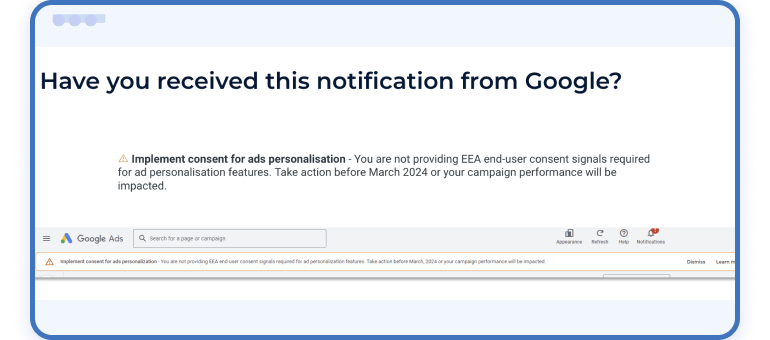As consumers become more data privacy-aware, Google is taking proactive steps to ensure that the privacy compliance requirements placed on them and other large tech companies by new regulations are also met by their third-party business customers. This helps ensure privacy compliance in the full digital ecosystem. As part of these enforcement efforts, Google has introduced strict requirements for verifiable user consent, particularly to enable continued access to Google ad personalization features. With a direct potential risk to companies’ bottom line, this move and other new requirements by Google could have a more significant impact on data privacy enforcement — and more quickly — than some government regulations and their enforcement by data protection authorities.

Shirin Eghtesadi, Google’s Director of Product Management, underscored the importance of these new measures:
“Google’s EU User Consent Policy (EU UCP) reflects the requirements of two European privacy regulations, the ePrivacy Directive (ePD) and the General Data Protection Regulation (GDPR), and requires marketers advertising with Google to obtain and respect end-users’ consent. Starting this year, we will enhance enforcement of the EU UCP for audience and measurement solutions.”
Google has also implemented a range of tools and features to help advertisers comply with their consent policy requirements and government regulations while still reaching their marketing goals. This guide delves into the essentials for obtaining and signaling consent for Google ads personalization and how to achieve and maintain compliance with Google Ads requirements in Europe.
Understanding Google’s alert and requirements for consent in advertising
“Implement consent for Google ads personalization – You are not providing EEA end-user consent signals required for ad personalization features. Take action before March 2024 or your campaign performance will be impacted.”
This prompt in your Google Ads dashboard isn’t just a suggestion. It’s a critical update that represents a fundamental shift in how advertisers must manage user data.
Google’s introduction of the consent requirement is not arbitrary. It’s a strategic response to the global call for data protection, with regions like the EU/EEA and the UK setting stringent privacy standards with the regulations they pass.
Why has Google introduced this requirement? Adapting to the privacy-centric trend
Google has introduced the new requirements to their ad tech customers to align with an evolving regulatory landscape that prioritizes user privacy. With the European Union’s General Data Protection Regulation (GDPR) and the ePrivacy Directive, there is a clear mandate for companies to ensure that personal data is processed lawfully, transparently, and for a specific purpose. Google’s consent requirements in ad tech and measurement tools aim to help advertisers meet these legal obligations and maintain trust with their users.
According to Google, these changes are part of their ongoing commitment to give users more transparency and control over their data, while providing advertisers with the tools they need to be privacy-compliant.
In short: If you saw the Google alert, you’re likely running ad campaigns on Google ad tech platforms or using Google Analytics to measure your ad revenue impact in Europe, but aren’t yet complying with all the recent requirements. Taking action to comply will ensure uninterrupted ad revenue after March 2024, when enforcement starts.
Learn why a Google-certified CMP like Usercentrics is essential for serving ads in the EU and EEA.
The regulations behind Google’s EU user consent policy and their implications for digital marketing
The GDPR and ePrivacy Directive are the primary regulation and directive informing Google’s EU user consent policy, together with the Digital Markets Act (DMA). The GDPR, in particular, affects any business that processes the personal data of EU residents, in many cases requiring explicit user consent for data processing activities. These laws have significant implications for digital marketing, where personal data is critical for targeting and personalization.
With the GDPR, the data privacy framework has shifted to empower users and place greater responsibility on advertisers.
Consent as a prerequisite
The GDPR has several legal bases for the lawful processing of personal data, but for digital marketing purposes, the most commonly needed one — user consent — mandates that it be freely given, specific, informed, and unambiguous. For advertisers, this means deploying clear consent mechanisms that are easy for users to understand and act upon before any personal data is collected or processed.
User rights front and center
The GDPR stipulates that users have the right to access their personal data, or have it corrected or deleted. Additionally, if a user rescinds consent for data processing, advertisers must cease collecting and processing it immediately. Therefore, advertisers must implement processes that enable users to learn about and exercise these rights easily, without obstruction.
Data minimization as a strategy
The principle of data minimization — collecting only the personal data that is necessary for stated purposes — compels advertisers to refine their data strategies, focusing on quality over quantity. This leads to more targeted, efficient, and effective advertising efforts.
Consent for Google ads personalization: Assessing the impact on ad campaigns
The implementation of consent for ads personalization can result in reduced visibility into user behavior, and, consequently, less data for optimizing campaigns. Advertisers might observe a decrease in the size of remarketing lists and a reduced ability to measure the performance of ads accurately.
The requirement for user consent can lead to a paradigm shift in campaign strategy and execution:
- Targeting challenges: limiting the use of detailed personal data for ad targeting without explicit consent may decrease the precision and relevance of ads, which can impact campaign performance metrics.
- Performance metrics fluctuations: as users exercise their right to opt out of data sharing, advertisers may witness changes in key performance metrics. This underscores the importance of adapting campaign strategies to remain effective under the new consent-based framework. Google suggests that advertisers should be prepared for these changes and understand that users’ consent choices will directly impact the data available for ad personalization and measurement.
How to adapt advertising strategy: Comply with Google’s EU user consent policy
To comply with Google’s EU user consent policy, advertisers should ensure that they have a viable and provable legal basis for collecting, sharing, and using personal data. In most cases, this will need to be valid user consent. Advertisers must provide clear information about their data use practices and obtain affirmative consent from users in the EEA/EA.
Google provides Consent Mode, which helps advertisers manage how Google tags behave based on user consent. Advertisers are encouraged to use this feature to maintain privacy compliance while still collecting valuable data where consent is given. Google’s tools also help to fill in gaps with modeling to provide data for insights even when users decline consent.
Read about consent mode GA4 now
Compliance with Google’s EU user consent policy: Risks and opportunities
Noncompliance with Google’s EU user consent policy carries risks, including potential loss of revenue and access to Google’s platforms, as well as a loss of user trust. However, there are also opportunities to build stronger relationships with users through transparent practices and to innovate in targeting and measurement with privacy in mind.
User’s personal data that is collected with proper consent will be processed according to the user’s choices, helping to ensure privacy compliance while enabling advertisers to personalize and measure ad performance for those who have consented.
Impact of not using Consent Mode in Google Ads before March 2024
Failing to activate Consent Mode before March 2024 if you run ad campaigns targeting users in the EU/EEA or UK, you will see the following consequences in your Google Ads account.
1. Remarketing audience limitations
Population of remarketing audiences will cease. There will not be an abrupt halt to all remarketing campaigns by March 2024, but the audience list will gradually diminish in size until it becomes ineligible due to size reductions.
2. Discontinuation of feed-based dynamic remarketing
The feasibility of implementing feed-based dynamic remarketing will be compromised. This feature is especially effective for running shopping campaigns and retargeting users based on the shopping products they have previously viewed.
3. Inoperability of New Customer Acquisitions (NCA) bidding
New Customer Acquisitions (NCA) bidding will cease to function when the remarketing list dwindles below 1,000 active members.
4. Inability to create lookalike audiences for Demand Gen
Crafting lookalike audiences for Demand Gen will no longer be feasible. Given that this capability is integral to this campaign type, it’s advisable to implement Google Consent Mode.
5. Limitations in customizing audiences and loss of audience insights data
Customizing audiences based on parameters such as “recent users 30 days” will no longer be possible. Additionally, valuable audience insights data will be lost.
Constructing a GDPR-compliant framework
Compliance with the GDPR and Google’s requirements for advertisers can be a strategic opportunity to reinforce trust and improve the quality of interactions with your audience. A robust GDPR compliance framework encompasses several critical elements:
- Comprehensive consent management: Implementing a Google-certified consent management platform (CMP) from a Google CMP Partner like Usercentrics is essential for managing and documenting user consents in a transparent and verifiable manner, and a requirement that Google has announced.
- Transparency as a trust builder: Clear communication about data practices not only satisfies GDPR requirements, but also builds user trust. Users are more likely to provide consent when they understand how their data will be used and see the value in providing it.
- Empowering user autonomy: User control over data is a key tenet of the GDPR. Advertisers must ensure that users can easily manage their consent preferences, thereby respecting their privacy and autonomy.
Preserving data and conversion integrity amidst changing consent requirements
The potential loss of data following the implementation of consent mechanisms is a critical concern for advertisers, but with the right strategies, this challenge can be mitigated.
To maintain data quality and limit the impact on conversions, advertisers can employ several proactive approaches:
- Anonymization and aggregation: Collecting data in aggregate or anonymizing user data allows advertisers to continue to gather useful insights without infringing on privacy.
- Advanced Consent Mode implementation: Google’s Advanced Consent Mode is a flexible solution that adjusts tracking and data collection based on user consent. It enables advertisers to retain a level of data collection and tracking for users who give consent while respecting the choices of those who do not.
Read about Google additional consent now
Addressing consent for personalization
Meeting the consent requirement for Google ads personalization involves a multifaceted approach that marries compliance with effective marketing.
To navigate the consent landscape successfully, advertisers should consider a multi-step strategy.
Choose a Google-certified CMP
If you’re using Google Ads and/or Google Analytics or Google Marketing Platform for serving personalized ads in the EU/EEA and UK, you need to review the way you obtain and signal consent from end users. A Google-certified CMP like Usercentrics CMP for web and mobile apps can help you obtain and manage valid user consent, and it integrates seamlessly with Google Ads.
Implement the latest version of Google Consent Mode
In November 2023, Google announced an update to Google Consent Mode. Advertisers must ensure that Google advertising products are properly configured to respond to consent signals from users, obtained via a consent management platform, enabling continued data collection in a compliant manner.
Educating users
Providing users with clear notifications about data sharing and compelling information about its value can improve consent rates and help ensure a positive user experience.
How to minimize the impact of potential data loss from CMP implementation and maximize conversions
To minimize the potential impact of losing data from Consent Management Platform (CMP) implementation, Google advises adopting privacy-safe methodologies for measurement, like conversion modeling, which uses machine learning to estimate conversions.
Advertisers should also leverage first-party data, contextual targeting, and privacy-centric machine learning models. By focusing on these areas, they can maximize conversions while respecting user privacy and compliance requirements.
Optimizing data collection with Google Consent Mode
Google’s updates to Consent Mode offer advertisers a sophisticated tool to navigate the new consent requirements without losing valuable data.
Consent Mode enables adaptive strategies for data collection that respect user consent.
- Dynamic data collection adjustment: Google’s tags can dynamically adjust their operation based on the user consent provided, ensuring that advertisers can maximize data collection within the boundaries of user preferences.
- Innovative conversion modeling techniques: For users who do not consent to full tracking, Consent Mode employs statistical methods to estimate conversions, enabling advertisers to maintain insights into campaign performance.
Adapting to data reduction after consent banner implementation
While consent banners may result in reduced data collection, there are strategies to mitigate this impact and continue to derive valuable insights from your campaigns.
Adapting to the reduction in data requires a proactive and informed approach.
1. Adopting privacy-first technologies
Usercentrics’ server-side tracking and other privacy-first technologies enable advertisers to collect and use data in a responsible and compliant manner.
2. Promoting informed consent
Transparent communication about the benefits of data sharing can lead to higher consent rates. Users are more likely to share their data when they understand the value proposition and personal benefits.
3. Designing effective consent interfaces
A well-designed consent experience with a focus on user interface and user experience best practices can significantly improve user interactions and potentially increase the rate of consent, thus preserving the flow of valuable user data.
Advanced data collection with Usercentrics
Usercentrics provides a suite of consent and preference management solutions that enhance privacy while enabling effective data collection.
- Prioritizing user privacy: Usercentrics’ technology is built with privacy as a core value, helping ensure that advertisers can collect data in a manner that respects user rights and complies with regulations.
- Server-side tracking: Usercentrics’ server-side tracking reduces the reliance on third-party cookies and provides a more secure and privacy-compliant way to gather user data.
- Universal consent: Collect, centralize, and activate zero-party user data, consent and preferences, giving your website and app users full control over their marketing permissions to deliver truly personalized brand experiences.
Embracing privacy-centric tools for ad measurement
Google offers a range of tools designed to help advertisers measure campaign performance while navigating the evolving privacy landscape and the gradual phasing out of third-party cookies.
Advertisers can use these tools to maintain campaign effectiveness in a privacy-first environment.
Advanced conversion modeling
Google Consent Mode’s conversion modeling provides advertisers with estimated conversion data, helping to compensate for any decrease in full tracking data from users who decline consent.
Improved measurement capabilities
Enhanced measurement accuracy enables a deeper understanding of campaign performance, enabling better decision-making and optimization efforts.
Adopting new tracking paradigms
As the advertising industry moves away from reliance on third-party cookies, adopting new tracking technologies such as server-side tagging helps advertisers stay competitive and privacy-compliant.

